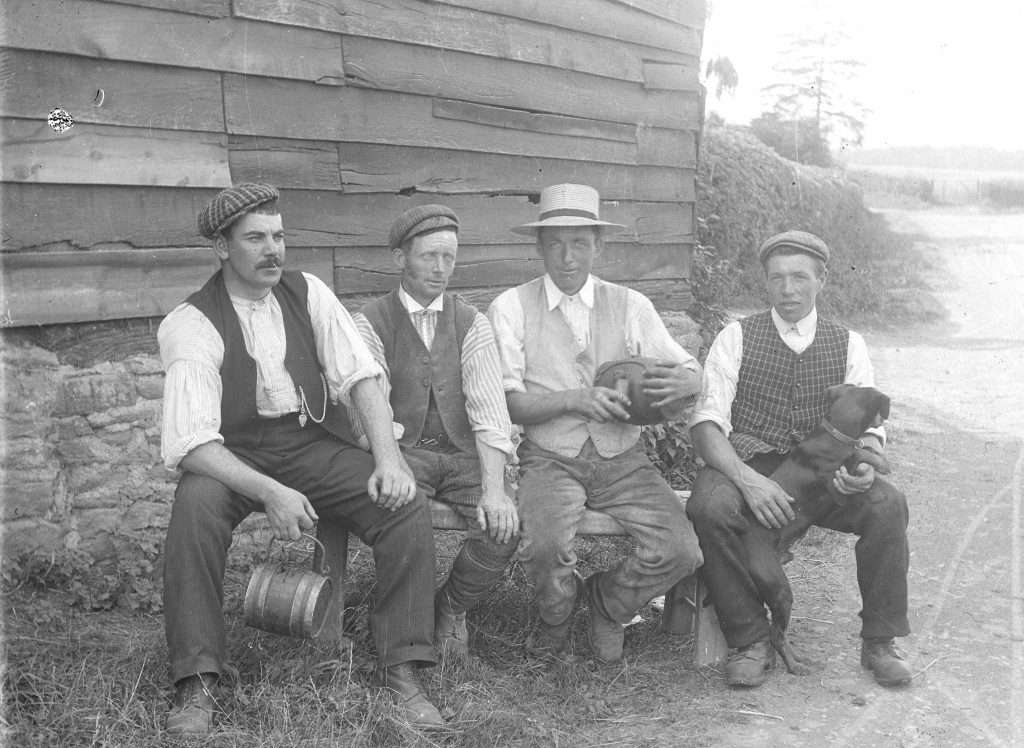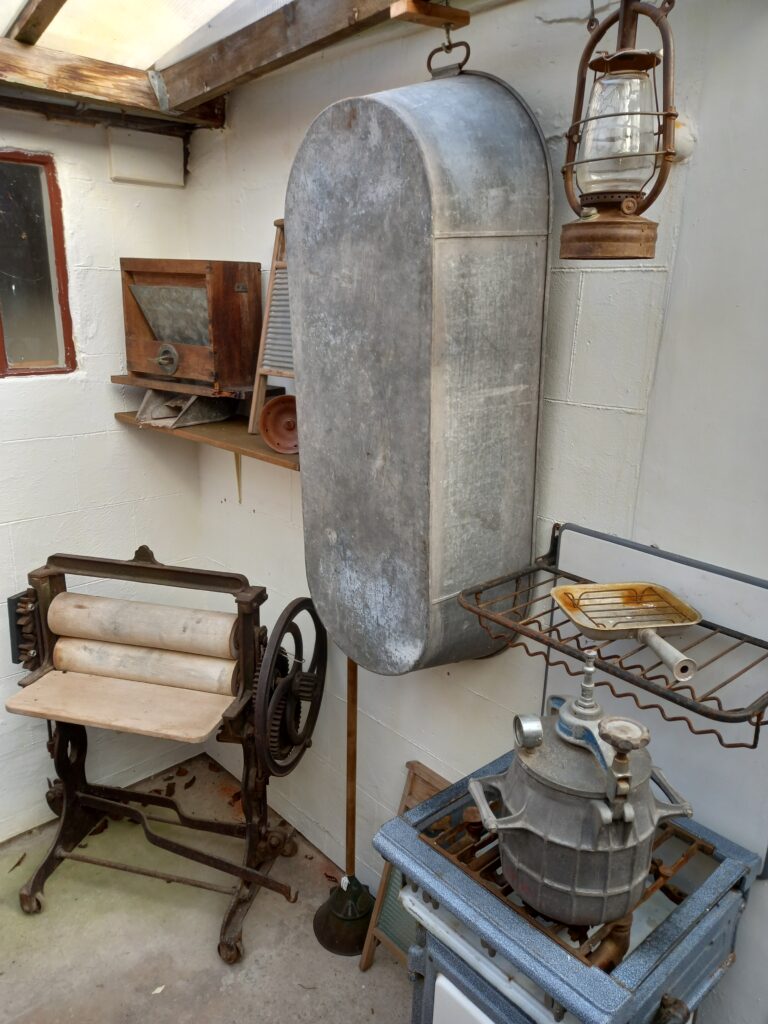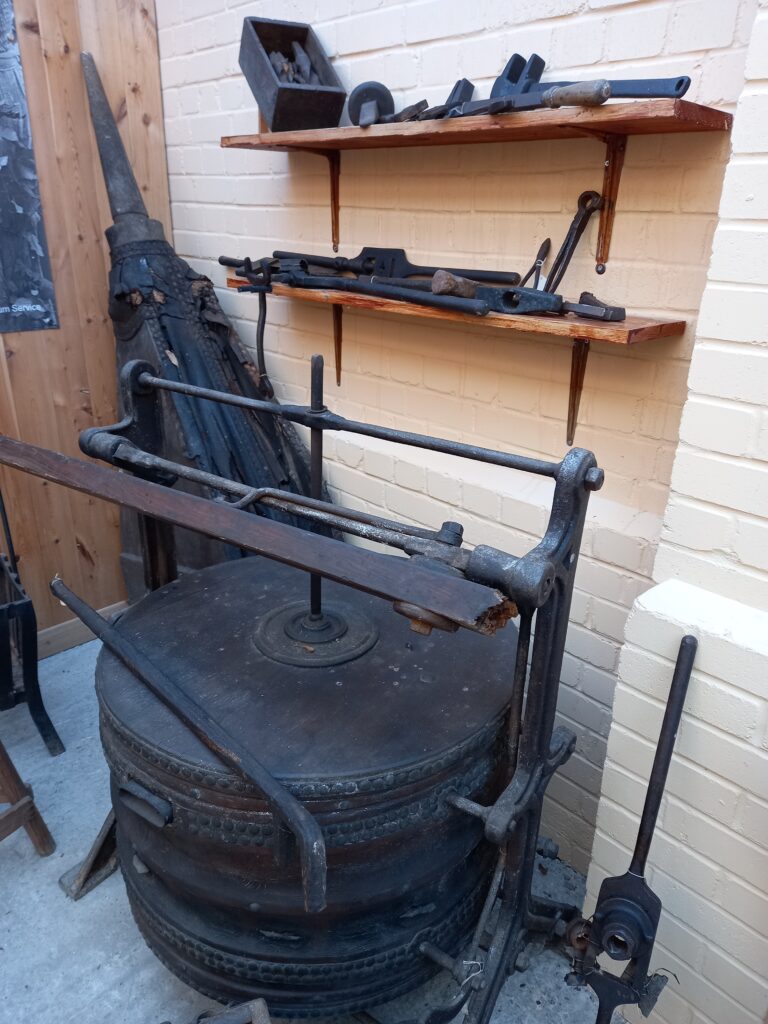Over its 1,350 year history Leominster has served many purposes – transport hub, frontier town, and manufacturing centre, for example. Its most important role over the centuries has been that of a market town in the centre of a rich agricultural landscape. This part of the Museum is about that role.
My memories of hop picking go from about 1940 until about 1950. It was always … all of September and about the first week in October. …. That was our holiday as such, and our parents …. had to go hop picking because they earned very good money there. …. We went to the biggest one …. Yeomans of Canon Pyon. And to us as children it used to seem like going to the end of the world, because it wasn’t like going up the road, it was 7 or 8 miles I suppose. …… They had the east-enders from London …..… it was their holiday ….., just imagine, coming to the country. And they used to come and mix with all the locals and ….. went down to the local pub at night and what have you, and have a wonderful time singing ….. of course there were a lot of painted caravans, with the gypsies. …… And I can remember the last day was always a very good day because that was the payday and they used to go up to the kilns and get their money. They used to have cards, as the busheller used to say 10 bushels, he used to write it down on the card, and they used to watch him like a hawk, because some of them were very much on the farmer’s side.
Pauline Davies

…After I’d got on up the dray loader thing, we used to put the hay on like. ……… I think I could put an acre on one dray. …………. It was very good like, starting so young I think I was a pretty good loader. …. I enjoyed that, and in the morning, [could] load three big wagons like, it took two to three hours to get them all. I can’t remember quite, but if it was all cocked up like, ready to load, you could load the wagons three times, perhaps, in a day. As I say cocking this hay up, I can remember going in them fields you’d hear the church clock striking. It was 11 o’clock some nights it was.
Arthur Evans

Together with corn and milk, his farm produced all sorts of fruit including apples, pears and plums, the best of which he picked by hand and sold at market. My three younger sisters and I frequently walked to the farm and helped with the picking. Very much lower in this pecking order …. were the artisans and poor farmers, whilst below them were the gang-leaders of the men and women – casual labourers who picked the hops, potatoes, sugar beet and fruit in the fields. Usually big, [and] tough …, these mostly female gang leaders had considerable influence in the poorer communities as they dictated who got work in the fields and earned money to put food on their table. The casual labourers who depended on their patronage crossed them socially or at work at their peril!
Roy Gough
I’ve gone swede pulling, I used to work in the fields a lot. Tater picking, but the only thing I couldn’t do was pea-picking. I could do it, but I wasn’t very good at it. Currant picking, strawberry picking, I used to love that. With my currant picking money I used to have a day out and go to Blackpool to see the lights.
Margery Hunt
I used to do sheep shearing as well, but I weren’t very good at that because I was only a little chap and the sheep were so big then like. If we had to go to a Shropshire sheep they were big ones then and they’d almost lift me off the ground! – . Oh, mechanical shears ….. When I was a kid I used to wind the wheels round for them – to shear a sheep like. You was about knackered when you’d finished one sheep. We used to do it for one sheep, and then we were so tired we’d have a good rest and somebody else would do it. And then the farmer or shepherd would do it himself like as well. Get through about 25 sheep a day, It was a long job shearing, it was, it really was.
George Oakley

My mother, her kept pigs, she was a proper farmer mind. We had some pigs, we was having them killed just before the Christmas. Dad said ‘Come on I’ll take you kids for a walk.’ I’d say ‘no, I’m gonna …’ ‘You won’t!’ he said, ‘you come along with me.’ He couldn’t bear it, how they squealed and that. Our mam would stand there and help and she used to do all the cutting up herself, and the jointing and that.
Margery Hunt
[He] offered me the job on the farm, and I’ve been there 25 years. I managed the farm at the finish like. And that’s when I was very interested in Hereford cattle….. Pedigree Herefords, and I can remember, entered my first bull at Hereford Market, and there was about 350 bulls there, and they was all sold in one day. Judged the one day and sold the next. I had 3rd prize with this one. The champion then made 250 guineas. It was such a good bull that we made 800 guineas.
George Oakley
Leominster had these wonderful markets on a Tuesday and a Friday. On a Friday you couldn’t walk up Etnam Street …. it was thronged. And you had a devil of a job to walk up High Street – no cars could come up at all, it was packed jammed with people, and people from the country all going about their business. ….. Leominster was absolutely busting. …. On Friday the ladies out in the country would bring in dressed chickens, and dressed rabbits and butter and cheese, and sell in there. That was marvellous, and of course we’ve lost all this.
Alec Haines
All fresh on a Friday it used to be lovely. Yes they was all stalls in the one part, and the cattle was over there, but this was in the one big market and they sold it by auction. Then some of them would sell it to you before the auction started, as I said it was really good, because you had fresh vegetables. ….. The cabbage and things like that used to last, you could get a dozen eggs and they’d last you. ….. It was so different.
Dorothy Oughton
I worked from well before 6 in the morning till 6 at night on the farm. … And often at harvest time, hay making and that, I would go out and be working until 10 o’clock. …… Come home, go to bed, get up. Farming as I said, was my father’s [job]. … it was good enough for him, it had to be good enough for us. I began my [2nd] job on my 15th birthday …. for 5/- (25p) per week, no holidays and no overtime. ….. I was bringing thirty cows in for milking at 6 am and finishing around 6 pm, assisting to milk, all by hand, no electricity, cooling the milk, washing buckets and cooling equipment and for a little while taking the milk varying forty to sixty gallons per day, in ten and sometimes seventeen gallon milk churns with horse and float to the railway station and load on to the train for Birmingham. In course of time …. the milk [was] collected by road, so it was only necessary to deliver the milk churns to the loading stand outside the farm gate.
Herbert Millichamp

Washing was just as white, I would say even whiter, than the best there is today. The River Pinsey ran along Vicarage Street, and there was washing stones, certainly in the last century. When we were living with my in-laws there was a big boiler in the corner in the back kitchen. You lit the coal fire underneath and then it went up through a chimney out. Every Monday the washing was done by all women in the town. If a man lit a bonfire he’d have been murdered. Wonderful, you do miss things like this when you’ve experienced it at my age, you really do.
Alec Haines

Dad, he got chlorine gas and when he came back from the Army the doctor told him he was not to have an indoor job, it would kill him. .[He] found that there was an opening for someone to go round the country with paraffin, soaps, powders and polishes. So he did that, and he…. started in about 1922. He sold Pinkabolic soap! Matchless Cleanser, Fairy Soap, Lifebuoy, Persil, Oxidol, Rinso, and then Omo came onto the scene. Silver Flakes, soap flakes. Candles, soda, toilet rolls, matches, toilet soaps of course – Lifebuoy Toilet. Knights Castile. Palmolive, Lux. And Fry’s cooking fat, but it was in a tin. Quite a variety, and then at one stage, it might sound strange, but we used to sell a cough mixture called White Cross. It was like liquorice – it was beautiful – I could drink that by the spoonful. He started with a horse and covered cart, or dray or whatever you like to call it. I used to go out with him, yes, I always enjoyed that. Then went on to a van just before my brother was born in 1933. I used to love going with him on the van.
Minnie Davies
I grew up near Knighton; I finished school then, they were very poor days, and I got a job at the May hiring day. Stand under the clock at Knighton they’d come and ask you, Farmer said ‘Do you want to hire, Boy?’ I lived in there and my first wage, it was £11 a year, and I don’t think I ever got that. Never had a pay packet, had to give father a few bob, and a few left for me.
Arthur Edwards
Oh there was a butler and a footman, housekeeper and housemaids, kitchen maids, cooks. That was in the house. And the of course there were gardeners. There was a head Gardener, and about four or five under-gardeners. Then on the farm, the estate farm was so much of it, the parks and one or two fields besides. They used to breed Ryland Sheep to show them, cattle, bulls, that sort of thing. They had stables there with racehorses. They had a groom, head groom and two under people working in the stables. And of course they had a keeper…..
Fred Parsons
Pig-men frequently visited the streets to collect any left over food for their animals, but little was wasted so they had a lean time. With meat being rationed and in short supply like everything else, poachers did a good trade in rabbits, selling them at two shillings and six pence each. At the same time, enterprising housewives made and sold faggots from their homes, the contents of which were hard to guess at, but I was sure included pigeon meat and sawdust.
Roy Gough
Until the middle of the 20th century, there were blacksmiths not just in Leominster, but in almost every one of the surrounding villages. They served many purposes – making and repairing all sorts of metal equipment, and shoeing the horses which were so important for agriculture and transport.

For excitement though, nothing equalled the blacksmiths shop in South Street, opposite the Bowling Green Inn. The blacksmith was a big, rough and good hearted man in a leather apron and the clang of his hammer could be heard far down the street. Sometimes he would let us pump the bellows and watch the sparks and flames from the white hot fire shoot up to the ceiling while he shod a horse, with the air becoming filled with the sizzling smoke and sweet smell of burning hoof. Oh, how I loved that smell!
At certain times of the year the road outside his shop would have a dozen or more huge carthorses lined up waiting to be shod and they were fun to pat and talk to.
Roy Gough
Like blacksmiths, every town and village had a carpenter. All kinds of things might be made in his workshop, depending on his skill – farm wagons, simple furniture, and even coffins. Joiners were skilled in producing finer furniture and cupboards, and coach builders had their own set of skills.
Before mechanical saws were invented, all timber had to be sawn by hand. This was relatively simple in the case of small tree branches, but much more difficult when a large tree had to be sawn into planks. In that case, the saws were too long and too heavy to be used by one person alone, so saw pits were used. They were deep holes in the ground over which timber is positioned to be cut with a long two-handled saw, by two people, one standing above the timber and the other below. The job of standing in the pit, often with your feet in water and sawdust falling on your head, was not a pleasant one, so the junior sawyer did it, and was called the ‘underdog’. The man above was known as the ‘top dog’ – names which survive with a different meaning today. Many towns, villages and country estates had their own saw pits., and the remains of holes can still be found in the Herefordshire landscape today.

Wheelwrights made the wooden wheels used on carts and carriages until the advent of the rubber tyre in the 19th century. They turned straight planks of wood into round wheels with spokes and an iron band round the edge.
In the past, most cheese was made on the farms where the milk was produced, rather than in factories. It was sold at local markets. The big tank on wheels is a cheese vat. The first stage of making a hard cheese is creating a curd from the milk. Then the whey needs to be drained off, and the curds compressed and processed. It is used to create curds. The walls and bottom of the vat are hollow and would have been filled with hot water to maintain the best temperature for the curds to form. The drainage hole is to allow the whey to be drained off, and the lever on the side allowed the vat to be tipped for emptying. The wheels allowed the vat to be moved from one area to another. It is big and therefore probably came from a dairy farm which made and sold a lot of cheese.
